
European Honey Buzzard
Pernis apivorus
Accipitriforme Order – Accipitridae Family
BIOMETRICS:
Length: 51-60 cm
Wingspan: 135-150 cm
Weight: 440-1000 g
DESCRIPTION:
European Honey Buzzard is a medium-sized raptor.
Colour of plumage varies but it is mainly reddish-brown. Tail shows three spaced dark bars. We can see typical bars across the underwings and they vary from white to dark brown. But horizontal bars on flight feathers and tail feathers are a good criterion to identify this hawk.
Fr: Bondrée apivore
All : Wespenbussard
Esp : Abejero Europeo
Ital : Falco pecchiaiolo
Nd : Wespendief
Russe : Обыкновенный осоед
Sd : Bivråk
Photographers:
Jean Michel Peers
JMPN PHOTOGRAPHIE
Jean Marc Rabby
Des Ailes et des Plumes
Other pictures and text by Nicole Bouglouan
Sources:
HANDBOOK OF THE BIRDS OF THE WORLD Vol 2 by Josep del Hoyo-Andrew Elliot-Jordi Sargatal - Lynx Edicions - ISBN: 8487334156
BIRDS OF PREY OF AFRICA AND ITS ISLANDS by Alan and Meg Kemp - Struik Publishers - ISBN: 1770073698
GUIDE DES RAPACES DIURNES – Europe, Afrique du Nord et Moyen-Orient de Benny Génsbol – Delachaux et Niestlé – ISBN : 2603013270
L’ENCYCLOPEDIE MONDIALE DES OISEAUX - Dr Christopher M. Perrins - BORDAS - ISBN: 2040185607
THE HANDBOOK OF BIRD IDENTIFICATION FOR EUROPE AND THE WESTERN PALEARCTIC by Mark Beaman, Steve Madge - C.Helm - ISBN: 0713639601
Wikipedia (Wikipedia, The Free Encyclopedia)
BirdLife International (BirdLife International)

We can see two morphs, pale and dark.
Pale morph birds have paler flight and tail feathers than dark phase. But all have dark carpal patch on the underwings. In flight, dark tips of primaries and barred tail are conspicuous. Tail is relatively long and slim. Wings are long and powerful.
Head is rather small and narrow. Male has often greyish head with golden eyes. Bill is pointed and hooked, with black tip. Grey lores are covered with scale-like, instead bristly feathers.
Tights are feathered. Legs and strong claws are yellow, with powerful toes. Feet are heavily scaled.
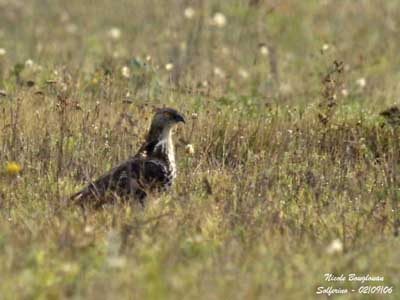
Female is larger than male, darker and browner on head and upperparts, with less conspicuous dark tips on primaries.
Juvenile has yellow cere and brown iris. It has shorter tail than adults, and lacks their distinctive plumage pattern. Some juveniles with pale head show a dark eye mask. They have larger black patches at the tip of the wings than adults, and they lack dark edges on primaries. Tail has more indistinct bars. Breast and belly show dark pattern.
They need three years to reach their adult plumage.

VOICE: SOUNDS BY XENO-CANTO
European Honey Buzzard utters a clear melodious “whee-oo” or trisyllabic “whi-whee-oo”.
Typical call of the male in flight is a loud “pleelu”.
Male and female give some “pewee” and utter “ki-ki-ki” when excited.
At nest, male and female give some blows to communicate.

HABITAT:
European Honey Buzzard breeds in woodlands where it can find its preferred food. Forests may are deciduous or conifers woodlands, with clearings, meadows and thickets.
RANGE:
European Honey Buzzard lives and breeds in Europe, and winters in tropical Africa. According to their European breeding range, they migrate above Gibraltar, Italia, Bosphorus and Caucasus. Young birds of one year old seem to remain in Africa during summer.
BEHAVIOUR:
European Honey Buzzard feeds mainly on insects, rather wasps and their larvae and pupae. It watches for wasp nests, flying at about 15 metres high, or from a perch. It may find the nest while it looks at insects, or following them even on long distance.
European Honey Buzzard catches wasps in aerial nests or in the soil. It digs out the soil with claws and bill until 40 cm depth. When the nest is found, it tears up the honeycomb to eat larvae and pupae, but also adults.
The skin around bill base and lores is protected by stiff small scale-like feathers. Nostrils are narrow as slits, to avoid penetrating insects and earth or wax.
European Honey Buzzard may hunt while walking on about 500 metres, catching insects. It does not catch insects on the wing, but it can run.

European Honey Buzzards are monogamous and pair bonds are permanent. They come back in mid-spring and start to build their nest at the same place each year.
At this period, the male performs aerial displays. It soars in inclined trajectory, and then, motionless in the air, it raises its wings and flutters them three or four times above its back. Then, it glides and repeats this aerial display above the nest or above the female.
European Honey Buzzard is a migratory hawk wintering in tropical Africa. Non breeding adults start the migration, followed later by breeding pairs and their young.
If alarmed at nest, both parents fly above the nest site at about 25 to 50 metres high, with some low flights, calling repeated long and loud whistles.
FLIGHT:
European Honey Buzzard flies with well held wings in circular glides. When soaring in direct flight, the wings are decurved with hanging hand. It often flies with held high head.
REPRODUCTION:
European Honey Buzzard’s nest is built by both adults at the same place every year or close to their usual nest site. It is located very high in tree, on a lateral branch. Nest is made with small fresh branches with leaves.
Female lays 1 to 3 white eggs, spotted brown, at two days intervals. Incubation lasts about 30 to 35 days and starts with the first egg laid. Both adults share incubation. Altricial chicks remain at nest during 33 to 45 days and are fed by both parents. Chicks are covered in short greyish-white down on back, and yellowish down on head and neck. When they are 15 days old, down is replaced by just growing primaries feathers.
At this time, chicks at nest are yet aggressive if threatened. They stand up with open bill and wings, and they try to attack predator or intruder by pecking.
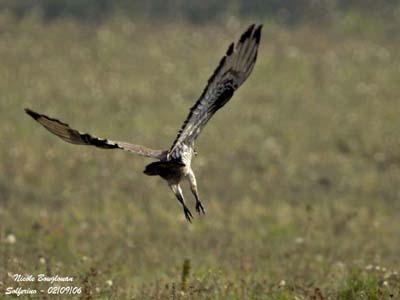
Both parents feed the young. When the male brings a frog, it tears up away from the nest before to give it to the female, and she feeds the young.
Female broods the chicks during the first days, leaving the nest only for preening and cleaning its plumage. She watches the nest from a nearby branch.
When they are 15 days old, male and female feed the youngs which start to extract larvae from holes themselves. At about 21 days of age, youngs have the dark plumage of juvenile except for the head, still covered with yellowish down.
They leave the nest at 40 days of age, climbing on nearby branches, but they feed and are fed into the nest. They become independent at about 55 days of age. They remain in their natal woodland about 20 to 30 days more, and then, they start their migration to Africa. They reach their sexual maturity at 2 to 3 years.
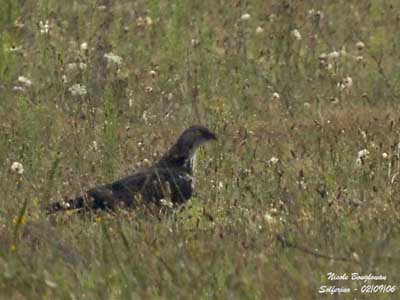
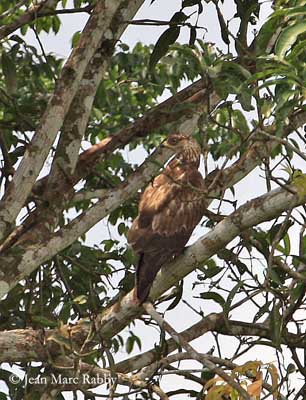
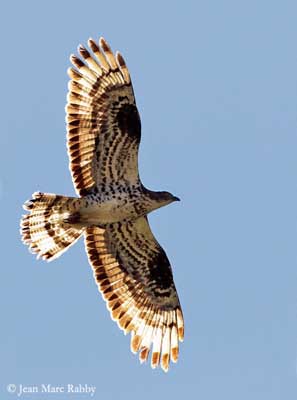
DIET:
European Honey Buzzard feeds mainly on bees and wasps, larvae and pupae. But it also eats various insects, earthworms, spiders, amphibians, reptiles, nestlings and small mammals. It also consumes fruit and berries in late summer.
PROTECTION/THREATS/STATUS:
European Honey Buzzard is still threatened by illegal hunting in southern Europe during migration. These actions involve declines in their populations.
However, this species seems to be stable and numbers often vary. Wet and cold weather at the beginning of nesting period plays an important role on wasp numbers, which are their main food.